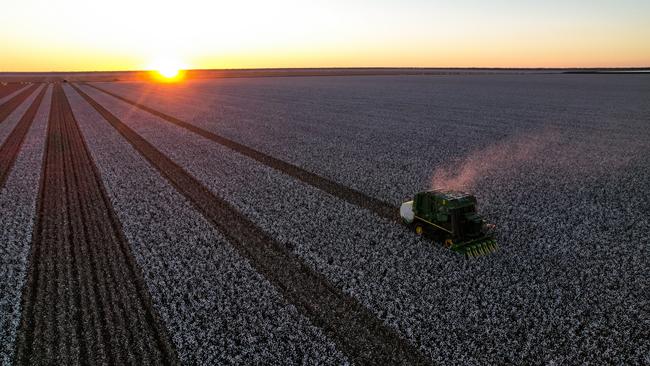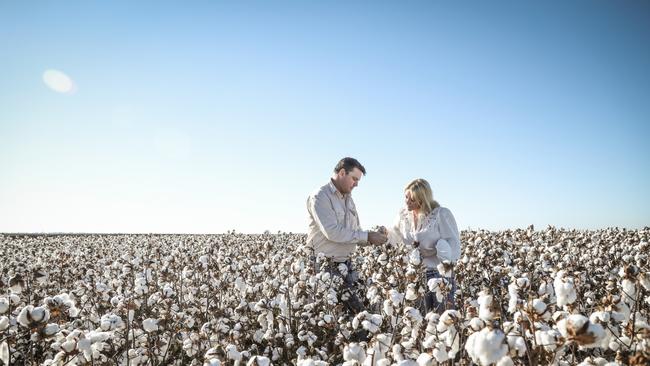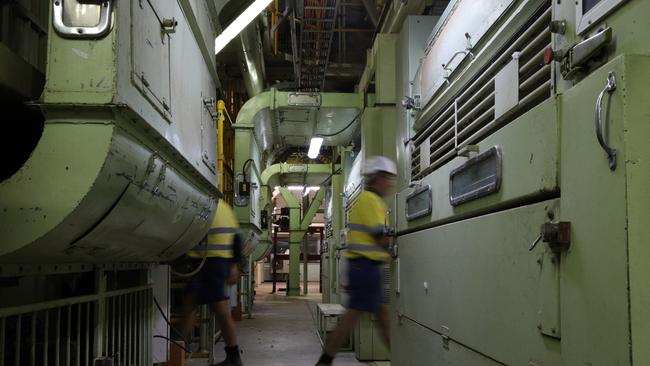Hydrogen: On-farm plant to produce 3800 tonnes of urea
A cotton farm in the northern Murray Darling Basin plans to make its own nitrogen fertiliser using sunshine, water and air. See how the project will work.

A cotton farm in the northern Murray Darling Basin has plans to make its own nitrogen fertiliser using sunshine, water and air.
The project, which claims it will save 20,000 tonnes of CO2 emissions per year, will be one of the first in Australia to produce its own fertiliser on-farm from green hydrogen.
As crop growers look for new ways to reduce carbon emissions, the technology offers a way to dramatically cut down one of the biggest drivers of agricultural emissions — those embedded in synthetic fertilisers — and potentially input costs too.
But experts say the government must draw up ground rules for the rapidly-developing technology, particularly around water use in drought-prone regions.

Wedged between the Gwydir and Mehi rivers, Sundown Pastoral Co’s Keytah cotton farm stretches as far as the eye can see on a rich, alluvial flood plain.
The farm markets itself on sustainability, producing 78,000 bales of cotton every year for “guilt-free fashion” under the Good Earth Cotton brand.
To produce that volume, the farm uses about 2100 tonnes of nitrogen fertiliser a year, a Sundown spokeswoman said.
The input comes with an environmental and financial cost, and Sundown co-owner David Statham said switching to more sustainable fertiliser was an “opportunity” for the farm.
“It’s so important for us to the part of leading this change for the environment and our communities”, he said in a statement.
Producing nitrogen fertiliser using traditional, gas-intensive methods, is energy intensive. On the average cropping property, about 27 per cent of emissions come from fertiliser production, meaning an operation that switches to sustainable fertilisers could cut its emissions by up to a quarter.
Fertiliser is also the biggest input cost on a cropping property. Even before record urea price spikes in 2022, the average Australian crop grower shelled out $158,547 on fertilisers, and Grain Growers Ltd has named domestic fertiliser production as one of the most important tools to buffer Australian producers from wildly fluctuating prices.
On Keytah, once the planned MW hydrogen electrolyser is up and running, it will produce all the ammonia the farm needs to fertilise its crop, plus another 1700t for sale.
The project was last week granted a share of $64 million in funding by the NSW government, and is part of a government push to drive down the cost of producing green hydrogen to $2 per kilogram.

How does it work?
Sundown had already started work on a solar farm — a 27MW installation called Wathagar — to power its cotton gin, when it was presented with a proposal from New Zealand energy company Hiringa to divert some of that energy to hydrogen and ammonia production.
The technique has already been mapped out by fertiliser company Yara, which is using green hydrogen to produce ammonia at its fertiliser plant in Karratha, Western Australia.
The process uses renewable energy — in this case solar — combined with water to produce hydrogen using an electrolyser, replacing the traditional Haber Bosch method, which uses gas.
For Hiringa, the Moree project was a chance to increase its footprint in Australia — a market where demand for hydrogen was “rapidly developing”, chief executive Andrew Clennett said.
Potential to earn carbon credits
The Good Earth Cotton brand already claims its cotton is ‘carbon positive’, sequestering more carbon in the soil than the plant uses in its life cycle, so an additional 20,000 tonnes in emissions abatement offers an opportunity for Sundown to earn carbon credits.
A company spokeswoman said the company had not yet determined how it would use the credits, and was keeping an eye on the carbon market.

Plans needed as technology expands
As the number of hydrogen projects in planning stages across the Murray Darling Basin grows, experts say plans are needed to make sure limited water is producing hydrogen for local use rather than export.
Deakin University centre for regional and rural futures director, professor Rebecca Lester, said green hydrogen technology showed a lot of promise, but “a scenario that I don’t think anybody wants to see” was “big companies with large pockets” buying up water to produce hydrogen and taking that water away from agriculture in the Murray Darling.
In the case of the Keytah project, the initial 12MW electrolyser was expected to use 9ML of water per year — slightly more than the 6-7ML needed to produce one hectare of cotton — with plans by Hiringa to scale up production to 112MW, using a total of 87ML/year, according to modelling by the company.
Water would be sourced from an existing water bore on the Keytah property, using existing allocations, Hiringa executive director David Heard said.
For Ms Lester, the concern was not smaller enterprises using the technology to produce ammonia for farms, but larger companies that may look to the Murray Darling a source of water to produce hydrogen for heavy machinery.
She said she hoped the first hydrogen projects in the Basin would spark a community conversation about water use.
“(In the Murray Darling Basin) there’s no restriction on what you can buy water for and use the water for. If you can afford to buy it, then you’re welcome to do what you like with it, effectively,” she said.
“While we absolutely want to see movement into clean energy sources, we actually need to have a think about how we progress that.”





